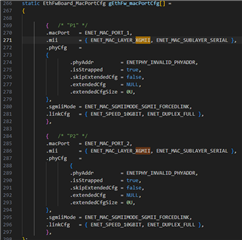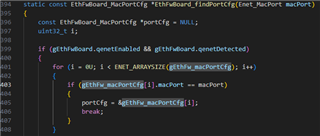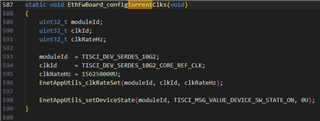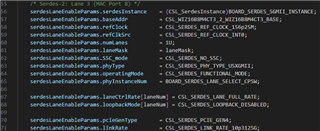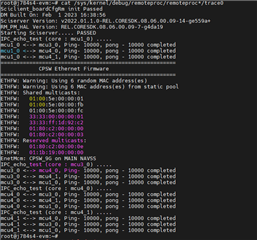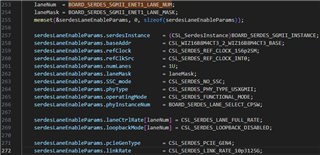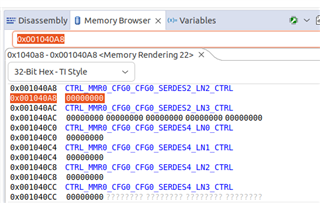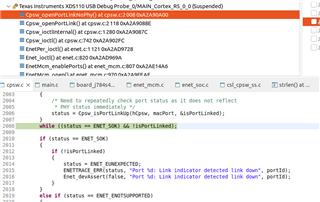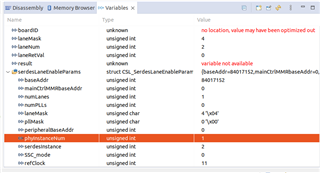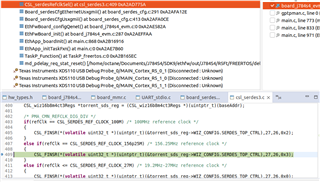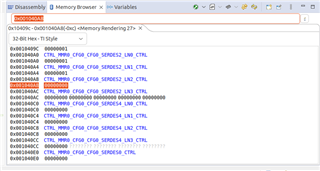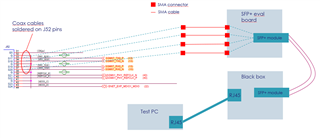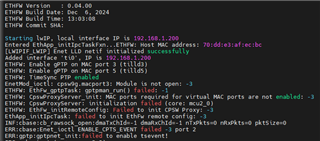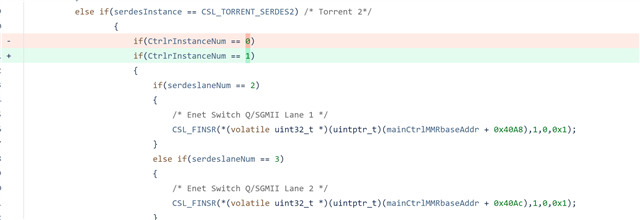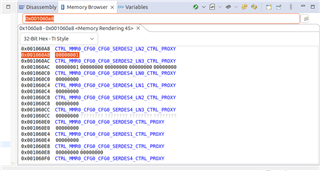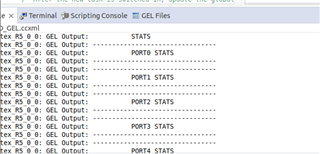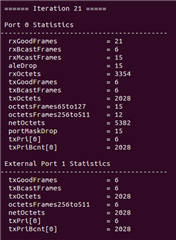Tool/software:
Hello,
I am trying to use 10G on XFI, for that I want to use a clock frequency of 156.25MHz. The idea is to use the external clock and to use lane 2 of serdes 2 as XFI. If it is also possible to get 156.25MHz from an internal clock that would be good to know.
Here is what I have done so far :
- In k3-j784s4-exp1-exp2-usxgmii.dts, I have changed the speed from 5000 to 10000 :
- &main_cpsw0_port1 {
status = "okay";
phy-mode = "usxgmii";
mac-address = [00 00 00 00 00 00];
phys = <&phy_gmii_sel_cpsw0 1>, <&serdes2_usxgmii_link>;
phy-names = "portmode", "serdes-phy";
fixed-link {
speed = <10000>;
full-duplex;
};
};
- &main_cpsw0_port1 {
- Still in k3-j784s4-exp1-exp2-usxgmii.dts, I checked that serdes2 lane2 was assigned, and as I see it is assigned by default :
- &serdes_ln_ctrl {
idle-states = <J784S4_SERDES0_LANE0_PCIE1_LANE0>, <J784S4_SERDES0_LANE1_PCIE1_LANE1>,
<J784S4_SERDES0_LANE2_IP3_UNUSED>, <J784S4_SERDES0_LANE3_USB>,
<J784S4_SERDES1_LANE0_PCIE0_LANE0>, <J784S4_SERDES1_LANE1_PCIE0_LANE1>,
<J784S4_SERDES1_LANE2_PCIE0_LANE2>, <J784S4_SERDES1_LANE3_PCIE0_LANE3>,
<J784S4_SERDES2_LANE0_IP2_UNUSED>, <J784S4_SERDES2_LANE1_IP2_UNUSED>,
<J784S4_SERDES2_LANE2_QSGMII_LANE1>, <J784S4_SERDES2_LANE3_QSGMII_LANE2>;
};
- &serdes_ln_ctrl {
- In k3-j784s4-evm.dts, I added a node for serdes2 containing the frequency I want to use (156.25MHz) :
- &serdes2_refclk {
clock-frequency = <156250000>;
};*
- &serdes2_refclk {
- In k3-j784s4-main.dtsi, I copied what existed with serdes for serdes2 :
- / {
serdes2_refclk: serdes-refclk {
#clock-cells = <0>;
compatible = "fixed-clock";
};
};
- / {
- Still in k3-j784s4-main.dtsi, I replaced &serdes_refclk by &serdes2_refclk and switched the status to "okay" :
-
serdes_wiz2: wiz@5020000 {
compatible = "ti,j784s4-wiz-10g";
#address-cells = <1>;
#size-cells = <1>;
power-domains = <&k3_pds 406 TI_SCI_PD_EXCLUSIVE>;
clocks = <&k3_clks 406 2>, <&k3_clks 406 6>, <&k3_clks 406 5>, <&serdes2_refclk>;
clock-names = "fck", "core_ref_clk", "core_ref1_clk", "ext_ref_clk";
num-lanes = <4>;
#reset-cells = <1>;
#clock-cells = <1>;
ranges = <0x05020000 0x0 0x05020000 0x00010000>;assigned-clocks = <&k3_clks 406 6>;
assigned-clock-parents = <&k3_clks 406 10>;status = "okay";
-
- Still in k3-j784s4-main.dtsiI also understood that I need to use &serdes2_refclk in assigned-clock-parents but I don't understand which PLL to use :
-
serdes2: serdes@5020000 {
compatible = "ti,j721e-serdes-10g";
reg = <0x05020000 0x00010000>;
reg-names = "torrent_phy";
resets = <&serdes_wiz2 0>;
reset-names = "torrent_reset";
clocks = <&serdes_wiz2 TI_WIZ_PLL0_REFCLK>,
<&serdes_wiz2 TI_WIZ_PHY_EN_REFCLK>;
clock-names = "refclk", "phy_en_refclk";
assigned-clocks = <&serdes_wiz2 TI_WIZ_PLL0_REFCLK>,
<&serdes_wiz2 TI_WIZ_PLL1_REFCLK>,
<&serdes_wiz2 TI_WIZ_REFCLK_DIG>;
assigned-clock-parents = <&k3_clks 406 6>,
<&k3_clks 406 6>,
<&k3_clks 406 6>;
#address-cells = <1>;
#size-cells = <0>;
#clock-cells = <1>;status = "disabled";
};
};
-
Here are my questions :
- Following the method I just exposed, the remaining task is to assign &serdes2_refclk in the assigned-clock-parents field in red, is it the right way to do ?
- Do we need to activate the external clock separately ? I imagine it should be activated in the u-boot source code, do you have an idea on its activation process ?
Thank you,
Kind regards,
Wissam



